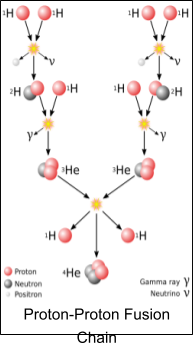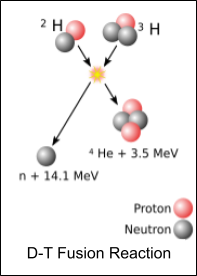What is Fusion Energy?
From an energy generation standpoint, fusion occurs when two light nuclei bind together to form a heavier atom, releasing significant amounts of energy. The most common ingredient in fusion in nature is the fusion of hydrogen nuclei together in stars, in what is known as the “proton-proton” chain, as shown to the right. In stars, fusion results from the immense temperature and pressure created in hydrogen plasma by gravity. Stars that are heavy enough and use up most of their hydrogen fuel can also fuse helium, fusing three (3) helium atoms into carbon (the “triple-alpha process”). The fusion of lighter elements to form heavier elements (without outside energy consumption) can continue up to iron, at which point no energy is generated. Beyond iron, fusion of heavier elements requires significant energy, typically occurring in the supernova of extremely heavy stars.
On earth, fusion for energy generation generally (though not exclusively) revolves around the fusion of deuterium (a hydrogen ion with one neutron) and tritium (a hydrogen ion with two neutrons), also known as the “D-T Fusion Reaction.” Deuterium is fairly common, accounting for 0.0156% of hydrogen atoms by number. Tritium is much rarer because it is radioactive, with a half-life of 12.3 years. However, it can be easily produced by the irradiance of lithium in a nuclear reactor. Like proton-proton fusion, D-T fusion produces helium, but most of the energy from the fusion reaction is carried in the extra neutron that is ejected from the reaction. While other elements can also be fused, the energy needed to cause the reaction is significantly higher than needed for D-T fusion, which is why it is the primary candidate for man-made fusion reactions.
There are three primary modes of fusion being explored for the controlled generation of energy (we will cover these in the next blogs in our series):
-
- Magnetic Confinement: Extremely strong magnetic fields are utilized to “squeeze” hydrogen atoms together to fuse them; examples include the tokamak and the stellarator.
- Inertial Confinement: Inertial confinement utilizes several high-energy beams (generally lasers) to ablate a capsule containing deuterium and tritium, compressing it to fusion.
- Pulsed Magnetic Compression: Also known as magnetized linear inertial fusion (MagLIF), pulsed magnetic compression utilizes linear magnetic fields to accelerate the ends of an hourglass-shaped column of D-T plasma towards the center while simultaneously compressing it, resulting in fusion.



